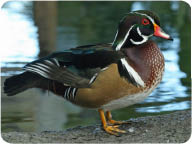 North American Wood Duck
North American Wood Duck
Aix sponsa
Description
The Wood Duck is one of the most brilliantly colored ducks in Illinois. The male is brightly colored with a complex facial design. His body consists of shades of maroon, black, and brown. His head is emerald green with white stripes. The female is brown or gray in color with a white throat and chest and a white ring around each eye. Both sexes have a crest of feathers which points downward at the back of the head.
Size
Wood Ducks are medium-sized ducks. They measure 17-20 inches in length and have a 28-inch wingspan. They weigh approximately 1.5 pounds.
Individual Animal Information
The Wood Ducks at Cosley Zoo were obtained from a duck breeder.
Adaptations
- One reason ducks are able to stay afloat in the water is because of air sacs inside their bodies that increase their buoyancy.
- Ducks’ feathers trap air in between them, which is another adaptation that helps them to float. Their feathers are also covered with a waterproof substance that keeps the ducks warm and dry.
- Ducks’ webbed feet allow them to maneuver easily in the water.
- Ducks are excellent fliers due to their streamlined bodies and powerful wings. Ducks and other birds also have hollow bones that weigh much less than the solid bones of mammals. This reduces their overall body weight and makes them light enough to fly. Wood Ducks have wings that are broader than those of other ducks, enabling them to make sharp turns between trees in wooded areas.
- Ducks do not have teeth, but they do have bumpy edges on their bills that help them to filter food out of the water. Food is then swallowed and ground up in the gizzard, a part of the stomach that contains small rocks for breaking down food.
- Unlike most ducks, Wood Ducks have claws on their feet that make them especially well adapted for perching.
Diet
In the wild, juvenile Wood Ducks feed on aquatic invertebrates, such as dragonflies, beetles, and spiders. This high protein diet helps them to grow rapidly. As adults, their diets change to plant material, including acorns, grains, fruits, and seeds. Much of their food is obtained by foraging on the ground. The ducks at Cosley Zoo are fed a commercially prepared duck diet.
Reproduction
Female Wood Ducks usually return to nest within a half-mile of where they were born. They nest in tree cavities, where they will lay between 6 and 15 white eggs. The female incubates the eggs, which will hatch approximately 1 month later. Shortly after hatching (usually within 24 hours), the young will jump out of the nest. They are able to fly after 8-10 weeks.
Shelter and Space Needs
Wood Ducks are found in wooded swamps and forests in the eastern United States and western coastal areas. They can also be found in the Southern part of Canada. They require a large number of trees with branches on which to perch and natural cavities to lay their eggs in. Northern populations migrate to the southern part of the United States for the winter, where they can more easily find food.
Life Expectancy
In the wild, the average life expectancy of the Wood Duck is thought to be 3-4 years. They can live up to 15 years in captivity.
Relationship with Man
Wood Ducks are said by some bird watchers to be the most beautiful ducks in North America, due to their colorful plumage. They play important roles in the ecosystem, both as predators and prey for animals such as owls and foxes.
Fun Facts
- Humans almost caused the extinction of Wood Ducks in the early 1900’s through habitat destruction and over-harvesting for food and feathers. Concerned citizens got together to save Wood Ducks by creating hunting seasons and bag limits and maintaining thousands of nest boxes for them.
- Shortly after hatching, young Wood Ducks jump out of their nest and land on the ground or in the water. They can survive a jump of up to 50 feet!
- The US Migratory Bird Treaty Act protects Wood Ducks. It is illegal to possess these ducks, any part of their bodies, their nests, or their eggs without a permit.
- Why don’t the ducks at Cosley Zoo fly out of the pond? They are pinioned, which means that a bone in their wing has been removed to prevent them from flying.






